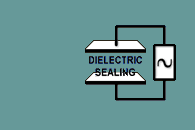ArcingIf the various adjustments are not made correctly, arcing through the material may occur. Arcing may also occur when the material to be sealed has different thickness at various parts of the seal or where the die overlaps the edge of the material. In these cases there can be arcing in the air gaps between the material and the die. Sometimes this can be remedied by increasing the pressure or decreasing the power. Arcing may also occur because of dirt or foreign matter on the material or dies. To avoid this, care must be taken to keep the material and the machine clean. Sharp corners and edges on dies may also cause arcing. The die edges should always be rounded and smooth. When arcing occurs, the dies must be carefully cleaned and smooth with emery cloth and solvent. Never try to seal material that had arced before. Surface Flash This is sometimes confused with arcing. A flash that occurs on the surface of the material during the sealing cycle. Smoke and a black carbon film is left. Clean all traces of carbon off. This is caused by any combination of these: Press pressure too low or press
stop set too high. The arc suppressor usually will not stop this unless it burns all the way thru. Arcing & Arc PreventionArc SuppressionSince electrodes are now being made larger and more complex, it is essential that no damage due to arcing occur on the die. Although dies are repairable, the loss of production time for repairs is prohibitive. Most sealing equipment is supplied with arc suppression devices. The function of this device is to sense the possibility of an arc and then turn off the R.F. power before a damaging arc can occur. A sensing control which can be set for various applications and sealing areas is easily pre-set before full production runs are made. The device does not prevent arcing but senses the arc, then shuts off power which prevents damage to the die. As an option, an Arc Suppressor Tester (Self Test ) can be added to the unit, which tests the arc suppressor before each cycle to insure proper operation. BuffersIn many cases sealing is improved by a thin layer of insulating material called “buffer”. This is attached to one or both dies to insulate the material to be sealed from the die. This does several things: It lowers the heat loss from the materials to the dies; it compensates for small irregularities in the die surface and may help to make a good seal even if the die is not perfectly flat; it decreases the tendency to arc when too much time or pressure is used. In general, it makes a better seal with less arcing. Buffer material should have good heat resistance and high voltage breakdown. Many materials used - bakelite, paper, glassine, Teflon, glass, mylar, silicone fiberglass, etc. Bakelite grade XXX about .010 to .030 inches thick can be used successfully in most cases. A strip of “Scotch” cellulose or acetate tape adhered to the shaped die is sometimes used to this advantage
| |
DIELECTRIC SEALING - 1555 Indusrial Drive, Unit E, Itasca, IL 60143 (630) 834-2010 FAX (630) 834-4935 © 2010 Dielectric Sealing |


